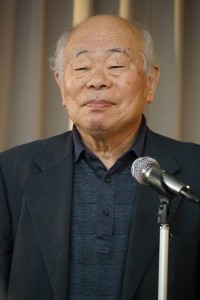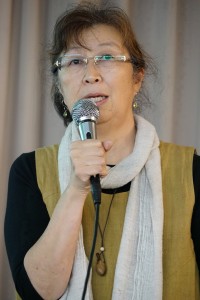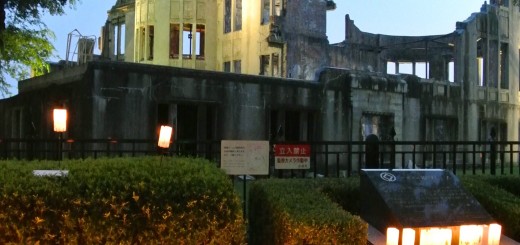Create a Nuclear-free World with Us — Report of the 40th anniversary gathering of Citizens’ Nuclear Information Center -Nuke Info Tokyo No.169
In September 2015, Citizens’ Nuclear Information Center marked its 40th anniversary. To commemorate the anniversary, we held a gathering on October 12, attended by 110 people. We invited Dr. Kōhei Hanazaki, philosopher, and Ms. Ruiko Mutō, Fukushima Nuclear Disaster Criminal Complainants Group, to deliver talks. Following their talks, an extremely pleasant party was held.
It was in 1954 that Japan decided to adopt nuclear power as a national policy and started to move toward becoming a nuclear power nation. Shortly thereafter, a small number of researchers and many people residing near planned NPP sites spoke up against the policy, concerned about the safety of the plants. Sixty years has passed since then, and the majority of the population is now against NPPs.
In this article, we would like to briefly introduce how CNIC was established, and summarize the talks of Dr. Hanazaki and Ms. Mutō.
1) National antinuclear rally, Kyoto, 1975
At the end of August 1975, Japan’s first national antinuclear rally was held in Kyoto over three days, being attended by 51 groups from NPP sites as well as 600 citizens and researchers, presenting the slogan: “Life-threatening nuclear power.” At that time, 59 nuclear reactors were already in service, being built, or planned, along the coastline of the Japanese archipelago. The slogan of the rally, “life-threatening nuclear power,” was taking shape without doubt.
In March 1975, a book named The Safety of Nuclear Power Generation was published (from Iwanami Shoten, Tokyo; in Japanese). It was perhaps the first book in this country that criticized nuclear power generation. An easier-to-read version of this book was issued under the name of Nuclear Power Generation (an Iwanami Shoten softcover; in Japanese) in February, 1976. These works were the achievements of research by the Nuclear Safety Issue Research Group, which had been active since 1972. Among the important members of the group were four physicists: Mitsuo Taketani (elementary particle theory), Shū Ono (solid-state theory), Tokunosuke Nakajima (nuclear engineering), and Yōichi Fujimoto (nuclear physics). It was in the early 1970s that concerned scientists started to criticize nuclear power plants.
We would like to trace back about 20 years, to March 2, 1954, the very next day after a U.S. hydrogen bomb test was performed near the Bikini Atoll. A number of tuna longline fishing boats had been exposed to radiation in the Pacific Ocean, including the heavily contaminated Daigo Fukuryū Maru (S.S. Lucky Dragon 5), but on March 2 a budget proposal of 250 million yen for nuclear power was suddenly submitted to the Japanese Diet, which approved the proposal. This gigantic budget became the trigger for post-war Japan to steer itself toward becoming a science- and technology-based nation.
In those days, many Japanese scientists, who had not forgotten the Hiroshima and Nagasaki atomic bombings, were against nuclear power research, because it might lead to the development of nuclear arms and, consequently, war. On the other hand, a good number of scientists were positive about research, both out of curiosity and the promise of research subsidies. The two groups of scientists held prudent discussions. Having become impatient, the pro-nuclear Diet member Yasuhiro Nakasone (who then belonged to the Kaishinto Reformist Party and later became a Liberal Democratic Party member and Prime Minister) reportedly remarked: “Because academics were wasting time, we slapped their cheeks with a bundle of notes.”
In the end, the Atomic Energy Basic Law was established in December 1955, incorporating compliance with the three nuclear power principles demanded by the Science Council of Japan, which were “openness,” “democracy,” and “autonomy.” The nuclear power promotion framework, led by politicians and supported by pro-nuclear academics, was thus established.
Returning to the 1970s, in September 1975, encouraged by the anti-nuclear rally in Kyoto, the Citizens’ Nuclear Information Center (CNIC) was established, led by Mitsuo Taketani as Director. At first, the organization was regarded as a place to exchange information about nuclear power generation among academics and researchers concerned with the safety of nuclear power plants. However, Jinzaburō Takagi (nuclear chemistry), who was the only full-time staff of the organization, had a different opinion: “Researchers should also be activists.” This controversy is commonly known in the as “watch-versus-hammer debate.” The metaphor is that scientists are like precision watches while activists are like hammers who stand up against reality. Being defiant of the old, conservative idea that experts should live in the worlds in which they specialize, Takagi was in pursuit of a new role for scientists; he believed that scientists should pursue both research and social activism.
After Taketani’s resignation, Takagi became the second Director of the CNIC. Since then, the organization has been pursuing the difficult path of conducting both research and activism, according to Takagi’s policy. Behind his idea lay the fact that he was deeply involved in the movement against the construction of the Sanrizuka Airport (today’s Narita International Airport), which was the most intensely fought controversy in Japan at the time. We should note that Takagi sincerely empathized with the farmers who, with bare hands, resisted the national authorities, which enforced the airport construction with bulldozers.
2) Kōhei Hanazaki — “Three main pillars of grass-roots philosophy in Japan”
Dr. Hanazaki, born in 1931, is a philosopher who became well known when he published Marukusu ni Okeru Kagaku to Tetsugaku (“Science and Philosophy in Karl Marx’s Thought,” in Japanese, published by Morita Shoten, Tokyo, 1969). As an associate professor at Hokkaido University, he became involved in the All-Campus Joint Struggle League students’ movement and in the actions resisting the Vietnam War. In November 1971 he resigned from the university after these experiences. Being outside the academic world, he has lived as an activist philosopher ever since, pursuing the very fundamentals of thought. He has been involved in various regional people’s movements, such as the Sanrizuka movement, resistance against the Date Thermal Power Plant and Tomari Nuclear Power Plant, and the rights recovery movement for the indigenous Ainu people. Dr. Hanazaki has also closely studied the pollution problems of the Ashio Copper Mine in Tochigi Prefecture, and the Minamata mercury poisoning in Kumamoto Prefecture. He has pursued his thinking about how people should live while continuously expressing his thoughts. He has authored many books, including Ikiruba no Tetsugaku — Kyōkan kara no Shuppatsu (“Philosophy in the Place of Living — Let Us Start from Empathy,” Iwanami Shoten, Tokyo, 1981) and the record of a talk with Jinzaburō Takagi, Akirame kara Kibō he — Ikiruba kara no Undō (“From Resignation to Hope — Movement from the Place of Living,” Nanatsumori Shokan, Tokyo, 1987).
At the gathering commemorating CNIC’s 40th anniversary, Dr. Hanazaki started his talk with a German newspaper article concerning nuclear power generation that he had read in Germany in April 2011, soon after the March 11 earthquake and Fukushima nuclear accident. He mentioned that, in the article, Cardinal Reinhard Marx, archbishop of Munich and Freising, and Jürgen Trittin, German Green Party, both urged that nuclear power plants be promptly discontinued, and vouched for the feasibility of the discontinuation. Dr. Hanazaki then explained the background to the subsequent statement and proposal of the German Ethics Commission on Safe Energy Supply, and introduced his long-worked ideas on Japanese grass-roots thought, compared with thought and culture in Germany and other areas of Europe.
Cardinal Marx stated that technology that is not beneficial to all generations, including nuclear energy, is an issue of Maß, or an issue of limits within which we should live, whatever lifestyle we wish to enjoy. According to him, the limit is a basic idea every person can have, even if not a Christian.
Dr. Hanazaki explained that, the word Maß, which can also be translated as temperance, originated from ancient Greek philosophy, and that the word refers to an ethical attitude of following the limits within which each person should live. Namely, we should preferably lead a lifestyle that complies with the needs related to climate change and resource limitations; we must satisfy our own needs with less energy.
Furthermore, Dr. Hanazaki made the point that all the decisions concerning nuclear energy should be based on values determined by society, which take priority over technical or economic values. “Society’s value determination is the most important, and being compliant with this is our responsibility in terms of ecology,” he stressed.
In further pursuit of this issue, Dr. Hanazaki said that people living on the Japanese archipelago should follow the fundamental culture that has been inherited up to the present time from the ancient era of Jōmon, during which all natural creations were considered to have spirituality, and should uphold the philosophy of peace and human rights that people became conscious of after the Second World War and position it as an important pillar of ethics.
In view of these thoughts, Dr. Hanazaki stated that the characteristics of the grass-roots thought of people in Japan could be summarized into three pillars: The first is to live as ordinary people — people who live being proud of themselves as commoners, without attempting to obtain power, authority, titles, or affluence. He mentioned, as models of people who have embodied this pillar, Shōzō Tanaka, who struggled to resolve the Ashio Copper Mine poisoning incident; Michiko Ishimure, who is living with Minamata victims; and philosopher Katsumi Takizawa, who was involved in the student movement at Kyushu University while holding to a policy of “living in the lowly position of a human being.” Regarding the second pillar, Dr. Hanazaki mentioned Seishin Asato of Okinawa, who advocated the “right to live,” which placed high ethical and spiritual values on a life closely connected with the basis of life. Dr. Hanazaki mentioned spirituality in nature as the third pillar, pointing out that all the people mentioned here, including indigenous Ainu people, lived and are living while sensing such spirituality. “I myself have had an urge to expose myself to it,” Dr. Hanazaki added.
At the end of his talk, Dr. Hanazaki expressed his great appreciation for the tenacious efforts by women in the anti-nuclear movement, and by people in Tsushima, Nagasaki Prefecture, who spent as long as two days deciding what antique documents could be lent out in response to a request. In stating this, he expressed his hope that in order to realize freedom from nuclear power, decisions should desirably be made based on thorough discussion.
3) Ruiko Mutō — “The nuclear accident has not ended”
“Hello, everybody. I am from Fukushima.” On the podium at the September 19 Good-bye Nuclear Plant Rally with 50,000 Citizens, held in Tokyo in 2011, Ms. Mutō addressed the audience, who had gathered from all over the country. The address was followed by a portrait of her hometown, contaminated by radioactivity:
Everyone, Fukushima is a very beautiful place.
Hama-dōri borders with the cerulean-blue Pacific Ocean on the east.
Naka-dōri produces many kinds of fruit — peaches, pears, apples.
The Aizu plain extends around Lake Inawashiro and Mount Bandai, and has golden rice so heavy that the stems bend downwards.
Lines of deep mountains form a picture frame for the rice paddies.
Blessed with green mountains and clean water, Fukushima is our home.
Ms. Mutō, a lover of the nature of Fukushima, used to lead an emotionally rich life in an environment full of nature in Miharu Town, Fukushima. This lifestyle was toppled by the Fukushima Daiichi Nuclear Power Plant accident following the earthquake of March 11, 2011. After working as a teacher at schools for disabled children, she opened a woodland cafe, Kirara, in 2003, and was leading a life enjoying the beauty of nature from season to season. She began to participate in the anti-nuclear movement after the Chernobyl accident. Today she works as the head of the Fukushima Nuclear Disaster Criminal Complainants Group, in pursuit of responsibility for the Fukushima accident.
Ms. Mutō also participated in a regional gathering in Kashiwazaki, Niigata on the day before this Tokyo gathering. She explained the current condition of Fukushima, and the updates of her group’s activities pursuing responsibility for the accident. Showing many photographs and illustrations, she also introduced the Fukushima people’s gathering organized by the Federation of Nuclear Accident Victims’ Organizations (abbreviated as Hidanren), as well as explaining about the federation’s action of submitting demands to the Fukushima prefectural government.
Although four and a half years has passed since the accident, the whereabouts of the nuclear fuel in the reactors is still unknown. The problem of contaminated water emissions is becoming extremely serious; it is still unknown when the frozen-soil barrier will be completed. Radioactive substances are emitted into the sky and sea every day, while 7,000 workers are forced to work in danger, exploited and exposed to radiation each day. The flexible container bags that contain radioactive wastes resulting from decontamination work have deteriorated, and a recent flood washed some of the wastes away.1) The air dose rates are high around these temporary waste storage sites.
The national government and Fukushima prefectural government canceled the designation of evacuation zones despite the air dose rates still not being at an appropriately low level, and decided to discontinue the governmental housing rental program for evacuees and compensation payments to the victims without first consulting the victims.
The emergence of many cases of childhood thyroid cancer in Fukushima is an alarming sign, but the governments are covering it up, and are attempting to cook up a new nuclear safety myth. In elementary schools in Miharu Town, a government textbook teaches children about “cohabitation” with radioactivity.
In Fukushima, more people have died due to impacts from the accident than due to the tsunami. Between their nostalgia for their hometown and anxiety about radioactivity, people are tired out both emotionally and physically. Around Ms. Mutō, eight people died this year: Five people died very suddenly, two from cancer, and one with malignant lymphoma. The torment Fukushima is experiencing is unimaginable.
On July 31, 2015, a court decision was made that three people, including the former TEPCO chairman and vice president, should be mandatorily indicted, which was a landmark development in the restoration of civil justice.
The Federation of Nuclear Accident Victims’ Organizations submitted a request to the governor of Fukushima, demanding withdrawal of the recent government decisions, namely, the discontinuation of the free-of-charge housing rental program, cancellation of the designation of evacuation zones, and discontinuation of compensation payments to victims. The federation organized a rally on October 27.
Recalling her pre-accident life enjoying the benefits of nature, and showing photographs of her beloved dog, Ms. Mutō stated in retrospect: “My understanding is that we need to think with our own head to live.”
(Yukio Yamaguchi, Co-director of CNIC)
1) This is explained in more detail here.



